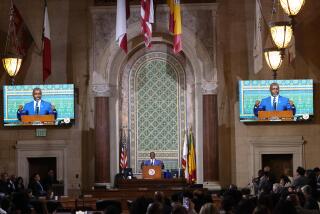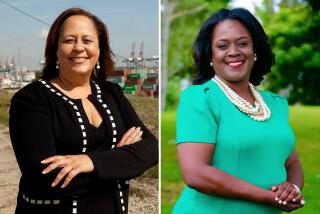CALIFORNIA COMMENTARY : A Family Spat Goes Public : Ex-allies Tom Bradley and Maxine Waters mix it up, but there’s room enough for both in L.A.’s black community.
- Share via
Over the past several weeks, there has been a startling public exchange of harsh comments between the two leading African-American politicians in Los Angeles--Mayor Tom Bradley and Rep. Maxine Waters. Waters criticized Bradley’s mayoralty and regretted that the black community had not held him more strictly accountable. Bradley and a group of other black politicians responded angrily, accusing Waters of being one who would rather talk than deliver.
What does this remarkable public argument mean?
When minority community leaders fight, the battle is often seen as personal--a sort of feud. The struggle is more baffling because of the chronic search for a single representative within a minority community with whom outsiders can deal. Reality is much more interesting. A lively, viable minority political community can support competing approaches, and even factions. Indeed, the rise of Tom Bradley’s coalition itself involved major factional battles within the black community.
Ironically, Bradley and Waters were on the same side of the factional struggles of the 1960s and 1970s. On the one side were black reformers led by Bradley, linked to white liberals in the California Democratic Council. Their mortal enemy was Mervyn M. Dymally, a power-broker allied with “regular” Democrats and Assembly Speaker Jesse Unruh.
The Bradley folks were the insurgents, the progressive crusaders for change. Dymally’s people sought traditional goals through power alliances. The Bradley alliance was strongest in the upwardly mobile western portion of the black community. Dymally strongholds were in the working-class neighborhoods. Between 1975 and 1978, Bradley and Dymally clashed in bitter state legislative campaigns, backing rival candidates in Democratic primaries. Having helped elect Bradley allies to the City Council, Waters became a pivotal figure in the legislative campaigns. She managed one campaign in 1975, then herself defeated a Dymally candidate for the Assembly in 1976. (I was Waters’ press secretary in those campaigns.)
The Bradley-Waters rift surfaced and grew as Waters carved out her own base and approach while Bradley’s early mayoralty thrived. Bradley did not formally endorse her in 1976, but she won anyway. More remarkably, she won in a district that was Dymally territory.
Meanwhile, Waters was building a Sacramento power base independent of Bradley, also developing a powerful progressive agenda and forming a close alliance with the Rev. Jesse Jackson.
Conflict was inevitable. Bradley was the big-city coalition builder, with his alliance of minorities, white liberals and the private sector. He governed as a centrist--a necessity in moderate, multiethnic Los Angeles. He could not, by temperament and political necessity, be a black spokesperson. By contrast, Waters became a fiery and articulate voice for the African-American community and for progressive causes. With the election of her ally Bill Clinton in 1992, Waters may have become the most influential black leader in the nation.
Bradley and Waters continued to run candidates against each other. In 1990, Waters backed Marguerite Archie-Hudson to succeed her in the Assembly after Waters’ election to Congress. Archie-Hudson easily beat Bob Farrell, Bradley’s choice. Bradley turned the tables in 1991 as his candidates Mark Ridley-Thomas and Rita Walters narrowly defeated candidates endorsed by Waters for City Council seats.
When former friends fall out--and especially when their allies speak for them--they can be uncharitable. To hear the Waters people, Bradley has been a do-nothing mayor with few achievements in the black community. To hear the Bradley people, Waters is all mouth and no action. As the Bradley era ends, it is fair to examine critically the flaws of each leader.
Flaws are there. But the portraits are also caricatures.
Bradley can point to some important successes--opening up City Hall to minority representation, affirmative action in city hiring and the painful, politically costly reform of the Los Angeles Police Department among them.
Waters is not just a talker. She is a very sophisticated politician with an ear for the streets and the rare ability to create and lead new social programs in inner-city communities, with or without government backing. And she can influence voters.
Indeed, Bradley and Waters have each filled roles that are essential to the political health of a minority community--the insider and the outsider.
Bradley, the former outsider, has become the consummate insider. While no stranger to the art of the deal, Waters has become a genuine voice of the excluded. Bradley has been a voice for interracial alliance, and Waters has sought to maintain a strong community identity. The tension between these approaches--usually kept private--can be a creative force as the African-American community in Los Angeles seeks a new direction in an uncertain political future in the post-Bradley era.
More to Read
Sign up for Essential California
The most important California stories and recommendations in your inbox every morning.
You may occasionally receive promotional content from the Los Angeles Times.













